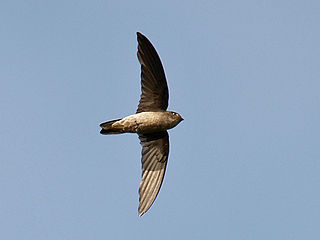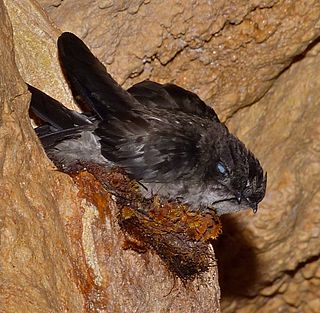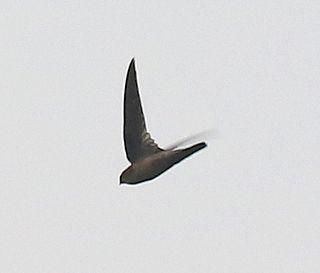
Swiftlets are birds contained within the four genera Aerodramus, Hydrochous, Schoutedenapus and Collocalia. They form the Collocaliini tribe within the swift family Apodidae. The group contains around thirty species mostly confined to southern Asia, south Pacific islands, and northeastern Australia, all within the tropical and subtropical regions. They are in many respects typical members of the Apodidae, having narrow wings for fast flight, with a wide gape and small reduced beak surrounded by bristles for catching insects in flight. What distinguishes many but not all species from other swifts and indeed almost all other birds is their ability to use a simple but effective form of echolocation to navigate in total darkness through the chasms and shafts of the caves where they roost at night and breed. The nests of some species are built entirely from threads of their saliva, and are collected for the famous Chinese delicacy bird's nest soup.

Aerodramus is a genus of small, dark, cave-nesting birds in the Collocaliini tribe of the swift family. Its members are confined to tropical and subtropical regions in southern Asia, Oceania and northeastern Australia. Many of its members were formerly classified in Collocalia, but were first placed in a separate genus by American ornithologist Harry Church Oberholser in 1906.

The mossy-nest swiftlet is a species of swift in the family Apodidae. Some taxonomists consider it to be a subspecies of the uniform swiftlet. It is found in northern Borneo, the Natuna and the Derawan Islands and Nias island off western Sumatra. Its natural habitat is subtropical or tropical moist lowland forests.

The Himalayan swiftlet is a small swift. It is a common colonial breeder in the Himalayas and Southeast Asia. Some populations are migratory.

The edible-nest swiftlet, also known as the white-nest swiftlet, is a small bird of the swift family which is found in South-East Asia. Its opaque and whitish bird nest is made exclusively of solidified saliva and is the main ingredient of bird's nest soup, a delicacy of Chinese cuisine.
The Mariana swiftlet or Guam swiftlet is a species of swiftlet in the family Apodidae.
The mountain swiftlet is a species of swift in the family Apodidae. It is endemic to the island of New Guinea and the nearby islands of Karkar, Yapen and Goodenough. It was once placed in the genus Collocalia but has been moved, with many others, to Aerodramus. The species is divided into three subspecies, with the nominate, A. h. hirundinacea ranging over most of New Guinea, the subspecies A. h. excelsus occurring over 1600 m in the Snow Mountains and Cartenz peaks of Irian Jaya and A. h. baru being restricted to Yapen Island. It occurs in alpine areas from 500 m to the treeline. Its natural habitat is tropical moist montane forests and other mountainous habitats in New Guinea. It also occurs in lower numbers in the lowlands near hills.
The Tahiti swiftlet or Polynesian swiftlet is a species of swift in the family Apodidae. While often compared to the Marquesan Swiftlet, this bird is often more pale faced. The subspecies is the Monotypic which means it does not include a subspecies.

The black-nest swiftlet is a species of swift in the family Apodidae. It is found in Brunei, Indonesia, Malaysia, Myanmar, the Philippines, Singapore, Thailand, and Vietnam. Its natural habitats are subtropical or tropical moist lowland forest and subtropical or tropical moist montane forest.
The Philippine swiftlet is a species of swift in the family Apodidae. It is endemic to the Philippines.
The bare-legged swiftlet is a species of swift in the family Apodidae. It is found in New Guinea, in subtropical and tropical moist montane forest.
Mayr's swiftlet is a species of swift in the family Apodidae. It is found in New Ireland and Guadalcanal.

The Palau swiftlet is a species of swift in the family Apodidae. It is endemic to Palau.

The Atiu swiftlet or Sawtell's Swiftlet is a species of bird in the swift family, endemic to Atiu in the Cook Islands.

The white-rumped swiftlet is a species of swift in the family Apodidae.

The Australian swiftlet is a small bird belonging to the genus Aerodramus in the swift family, Apodidae. It is endemic to Queensland in north-eastern Australia. It was formerly included in the white-rumped swiftlet but is now commonly treated as a separate species. It has two subspecies which are occasionally regarded as two separate species: A. t. terraereginae and A. t. chillagoensis.

The island swiftlet, also known as the Caroline swiftlet, Micronesian swiftlet, or Caroline Islands swiftlet, is a species of swift in the family Apodidae. Some taxonomists consider it to be a subspecies of the uniform swiftlet. It is endemic to the Caroline Islands, and its natural habitat is subtropical or tropical moist lowland forests.
The volcano swiftlet is a species of bird in the family Apodidae formerly considered conspecific with the Himalayan swiftlet. It is endemic to several sites in western Java in Indonesia.

The Apodinae are a subfamily of swifts and contain the following species:











